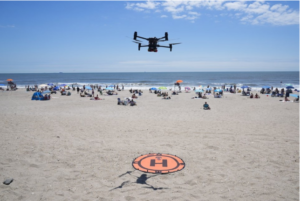

The utilization of drones to surveil New York City’s beaches for sharks and distressed swimmers has stirred up unexpected opposition from a rather feisty group of local residents: the shorebirds. Ever since these drones began their patrols in May, they have been consistently harassed by flocks of birds, compelling city agencies, including the police department, to alter their flight strategies. Although the frequency of these attacks has diminished somewhat, concerns persist among wildlife experts regarding the potential impact on endangered bird species that nest along the coastline.
Veronica Welsh, a wildlife coordinator at the Parks Department, described how the birds reacted strongly to the presence of drones from the outset. She noted, “They will fly at it, they’ll swoop at it, they’ll be vocalizing. They think they’re defending their chicks from a predator.” Despite these confrontations, no birds have been harmed thus far, although there have been several near misses. Despite the presence of inflatable life rafts on the drones designed for rescues, they have yet to be deployed successfully. The drones did, however, identify a shark on Thursday, resulting in the closure of a significant portion of the beach.
City officials attribute most of these “swarming incidents” to American oystercatchers, a species known for its distinctive orange bill, which nests this time of year on Rockaway Beach. Although their population has shown improvement in recent years, federal authorities still classify them as a species of “high conservation concern.” David Bird, a professor of wildlife biology at McGill University, suggested that while the birds might eventually acclimate to the drones, there is also a risk that the drones could induce stress responses leading birds to abandon their nests, as was observed with elegant terns in San Diego following a drone crash.
Rockaway Beach, a popular summer spot for New Yorkers, is home not only to American oystercatchers but also several tern species and piping plovers, the latter being the city’s only federally endangered bird species. Local officials closely monitor these plovers during the nesting season, restricting access to portions of the beach where they nest, including from drones.
The city’s Emergency Management Department, responsible for additional drone flights over the beach, has raised awareness of this coastal conflict with other drone operators in the police and fire departments. This has prompted adjustments in flight paths to steer clear of oystercatcher nesting areas. Natalie Grybauskas, the department’s assistant commissioner, remarked, “We pointed out that there’s a nest here and there’s two angry parents who don’t want you anywhere near their eggs or their babies.”
Since these measures were implemented, agencies have conducted briefings on the issue, marking a departure from their usual focus on emergencies such as fires and building collapses. Despite these precautions, reports from beachgoers suggest that groups of birds continue to confront drones in flight.
New York City is not alone in employing drones for beach surveillance; Long Island officials initiated a similar program following a series of shark incidents last summer. Unlike the NYC drones, these devices are smaller, quieter, and lack flotation capabilities. Similarly, lifeguards in Australia have utilized drones in recent years for shark monitoring and rescue missions.
Mayor Eric Adams, an advocate of drone technology, has praised NYC’s drone initiative as a critical addition to water safety efforts, especially amidst challenges in recruiting lifeguards for city beaches. This summer alone, four drowning fatalities have occurred, matching last year’s total. Following the disappearance of two teenagers off a beach near Rockaway, the NYPD deployed drones in the search and recovery operation, which tragically concluded with both bodies being discovered on the shoreline.
In addition to these somber incidents, footage captured by fire department drones has highlighted lifeguards aiding struggling swimmers caught in rip currents at Rockaway Beach. Christopher Allieri, founder of the NYC Plover Project, a bird conservation group, acknowledged the city’s innovative approach to water safety but emphasized the need for further precautions to safeguard shorebird populations. He commented, “Wildlife in New York is often an afterthought. We should be asking ourselves how we can use this technology in a way that works for all New Yorkers, and that includes those with feathers.”
The ongoing clash between New York’s beach drones and its avian inhabitants underscores the delicate balance between public safety and environmental conservation. As city officials continue to refine their drone strategies, the hope remains that innovative technological solutions can coexist harmoniously with the natural habitats of New York’s shoreline wildlife.

Leave a Reply